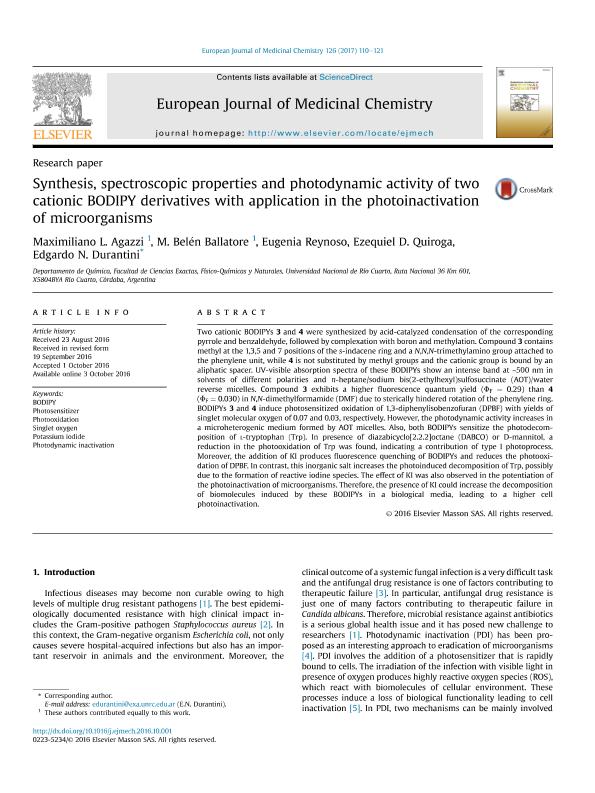Artículo
Synthesis, spectroscopic properties and photodynamic activity of two cationic BODIPY derivatives with application in the photoinactivation of microorganisms
Agazzi, Maximiliano Luis ; Ballatore, María Belén
; Ballatore, María Belén ; Reynoso, Eugenia
; Reynoso, Eugenia ; Quiroga, Ezequiel Dario
; Quiroga, Ezequiel Dario ; Durantini, Edgardo Néstor
; Durantini, Edgardo Néstor
 ; Ballatore, María Belén
; Ballatore, María Belén ; Reynoso, Eugenia
; Reynoso, Eugenia ; Quiroga, Ezequiel Dario
; Quiroga, Ezequiel Dario ; Durantini, Edgardo Néstor
; Durantini, Edgardo Néstor
Fecha de publicación:
10/2016
Editorial:
Elsevier Masson
Revista:
European Journal of Medical Chemistry
ISSN:
0223-5234
Idioma:
Inglés
Tipo de recurso:
Artículo publicado
Clasificación temática:
Resumen
Two cationic BODIPYs 3 and 4 were synthesized by acid-catalyzed condensation of the corresponding pyrrole and benzaldehyde, followed by complexation with boron and methylation. Compound 3 contains methyl at the 1,3,5 and 7 positions of the s-indacene ring and a N,N,N-trimethylamino group attached to the phenylene unit, while 4 is not substituted by methyl groups and the cationic group is bound by an aliphatic spacer. UV-visible absorption spectra of these BODIPYs show an intense band at ∼500 nm in solvents of different polarities and n-heptane/sodium bis(2-ethylhexyl)sulfosuccinate (AOT)/water reverse micelles. Compound 3 exhibits a higher fluorescence quantum yield (ΦF = 0.29) than 4 (ΦF = 0.030) in N,N-dimethylformamide (DMF) due to sterically hindered rotation of the phenylene ring. BODIPYs 3 and 4 induce photosensitized oxidation of 1,3-diphenylisobenzofuran (DPBF) with yields of singlet molecular oxygen of 0.07 and 0.03, respectively. However, the photodynamic activity increases in a microheterogenic medium formed by AOT micelles. Also, both BODIPYs sensitize the photodecomposition of L-tryptophan (Trp). In presence of diazabicyclo[2.2.2]octane (DABCO) or D-mannitol, a reduction in the photooxidation of Trp was found, indicating a contribution of type I photoprocess. Moreover, the addition of KI produces fluorescence quenching of BODIPYs and reduces the photooxidation of DPBF. In contrast, this inorganic salt increases the photoinduced decomposition of Trp, possibly due to the formation of reactive iodine species. The effect of KI was also observed in the potentiation of the photoinactivation of microorganisms. Therefore, the presence of KI could increase the decomposition of biomolecules induced by these BODIPYs in a biological media, leading to a higher cell photoinactivation.
Archivos asociados
Licencia
Identificadores
Colecciones
Articulos(CCT - CORDOBA)
Articulos de CTRO.CIENTIFICO TECNOL.CONICET - CORDOBA
Articulos de CTRO.CIENTIFICO TECNOL.CONICET - CORDOBA
Citación
Agazzi, Maximiliano Luis; Ballatore, María Belén; Reynoso, Eugenia; Quiroga, Ezequiel Dario; Durantini, Edgardo Néstor; Synthesis, spectroscopic properties and photodynamic activity of two cationic BODIPY derivatives with application in the photoinactivation of microorganisms; Elsevier Masson; European Journal of Medical Chemistry; 126; 10-2016; 110-121
Compartir
Altmétricas



